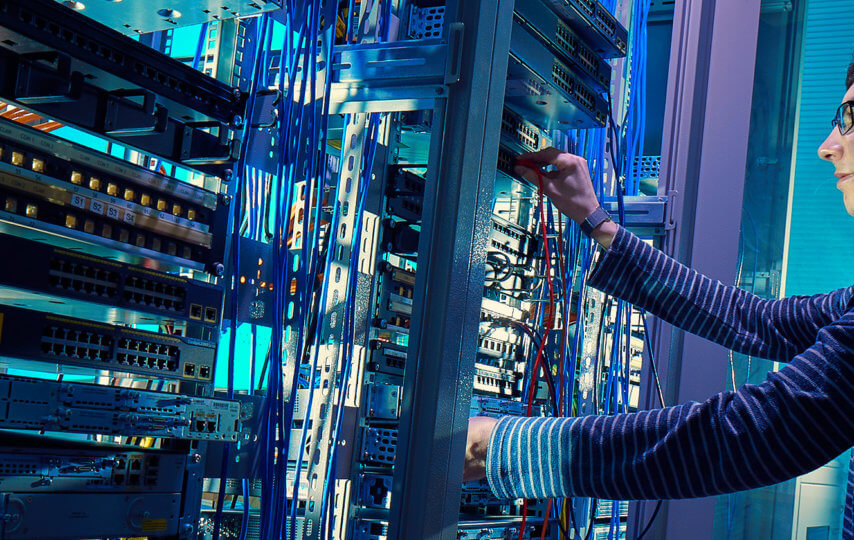Technology is constantly evolving, offering businesses a higher chance at productivity and information security. However, these tools require the right network to support them and use them to their full potential. Structured cabling is a form of an infrastructure that is composed of smaller elements. You can have a structured cabling system at an office or an entire building depending upon your needs.
Structured cabling is a network cabling solution that helps you organize your IT infrastructure and future proof your building by incorporating the ability to accommodate new hardware and technology. It will ensure that your business can support the need for an increased amount of data needs, speed, and bandwidth.
Types of Cables Used in Structured Cabling
Cables serve as mediums through which information moves from one network to another. Structured cabling service providers use different kinds of cables, and each cable serves a different purpose in the structured cabling system. The kinds of wires and cables you use in your system depend upon your specific needs. Here is a list of some commonly used cables in structured cabling systems.
- Fiber Optic Cable
Fiber optic cables are just like electrical cables in appearance, but these are made from optical fibers and carry images and signals in the form of light. These cables are made out of plastic or silica and coated with multiple layers of plastics. It consists of a glass core surrounded by multiple layers of sheathing material. Instead of transmitting electrical signals, these cables use light signals to transfer data.
Therefore, these cables are best for areas with a lot of electrical interference. Fiber optic cables can transmit signals to much longer distances as compared to other cables available in the market. It can also support greater download speeds and fiber optic best choice for cloud computing, but its reliability depends upon the type of cable and material used. So, make sure to consult structured cabling UAE based experts if you want to upgrade networking in your building.
- Coaxial Cable
Coaxial cable has a single copper conductor in the center. It includes a plastic layer that sheaths the center conductor and braided metal shield. The braided metal shield helps block any form of interference from outside, including fluorescent lights, motors, heavy equipment, etc. In comparison to the fiber optic cables, coaxial cables are difficult to install, but these cables are highly resistant to signal interference.
These cables come in different specifications. Thin coaxial cables, also called thinnet or 10Base2, are cables carrying Ethernet signals. The 2 refers to the maximum length of the cable (200 meters). There is also a thick coaxial cable, also called thicknet or 10Base5, that can carry Ethernet signals to a maximum length of 500 meters. It makes thick coaxial cable perfect for longer lengths and systems.
- Twisted Pair Cable
Twisted pair cables are mostly used to connect offices and homes with a telephone company. These are the oldest types of cables available in the market. There are two types of twisted pair cables, as follows:
- Unshielded Twisted Pair Cable
Unshielded Twisted Pair Cables are the most popular type and best option for schools and hospital networks. UTP cable has four pairs of wires inside its jacket, and it comes in different qualities. It comes in a telephone grade wire to extremely high-speed cables. It comes in different categories that support different speeds of Ethernet.
- Shielded Twisted Pair Cable
Unshielded Twisted Pair Cable is no doubt the least expensive option available in the market, but it may be influenced by the radio and electrical interferences. If you install these cables in areas with a lot of interferences, you will face signal losses quite frequently. Therefore, a solution to that is the Shielded Twisted Pair Cable. These cables come in three different forms.
- Each wire is shielded individually with foil.
- There is a braided shield inside the jacket that is covering the wires
- There is a shield around each individual wire as well around all the wires (also known as double shield twisted pair).
Consider approaching structured cabling UAE based experts to see which cable will fit your needs, i.e., unshielded or shielded twisted pair cable. These experts will ensure that you have a long term networking solution that is reliable.
Main Components of a Structured Cabling Solution
There are three main components of a structured cabling system discussed below:
- Patch Panels
A patch panel connects cables to a switch. It is also called patch bays and is attached directly to network racks. Patch panels are like a connection hub that bundles up all the connections to another network like a LAN connects to the internet.
- Switches
A switch is a component of the system that receives, processes, and sends data. Switches connect patch panels to a network to share data and access the internet.
- Trunk Cables
Trunk Cables connect to the patch panel. Trunks consolidate the number of wires running from one patch panel to the other. These are essential for grouping wires that are bound into a big cable to make things organized and neat.
Get Structured Cabling Today
Structured cabling can be used in any industry and is not limited to just office buildings or indoor spaces. Different sectors like manufacturing, education, and healthcare have opted for structured cabling because of its numerous advantages. Why? Because structured cabling can handle all kinds of data and media, that is a must for business growth. It is becoming quite popular among the corporate world because it helps you control and manage networking and energy use in your office space and homes. It future proofs your establishment because it can support modern and emerging technology, including sustainable energy options.
So, if you want to make the most out of these benefits, an experienced data cabling company in UAE will have all the resources to install structured cabling at your office.













